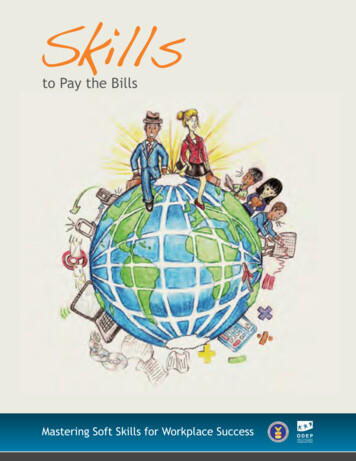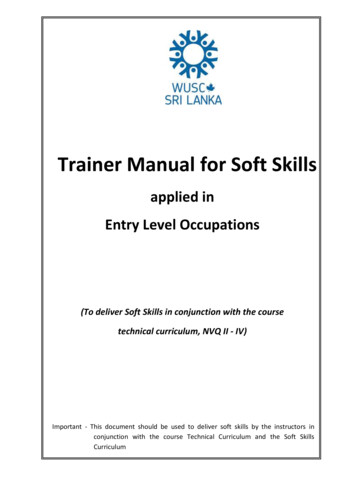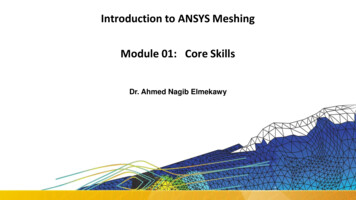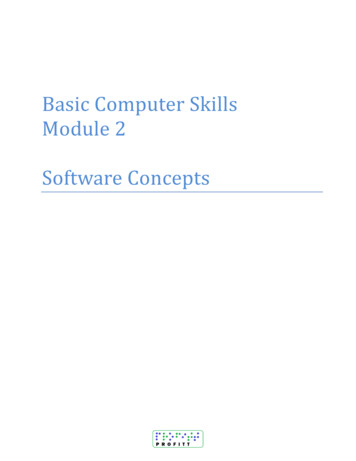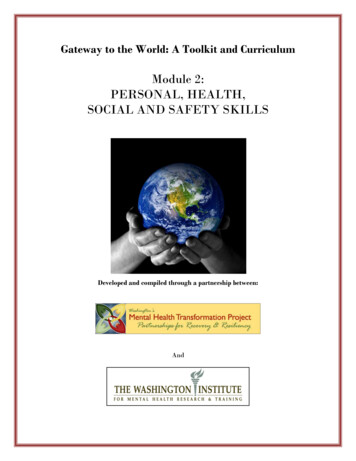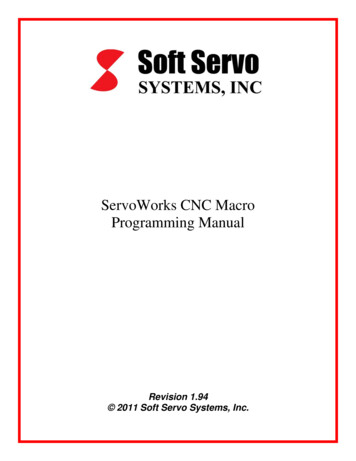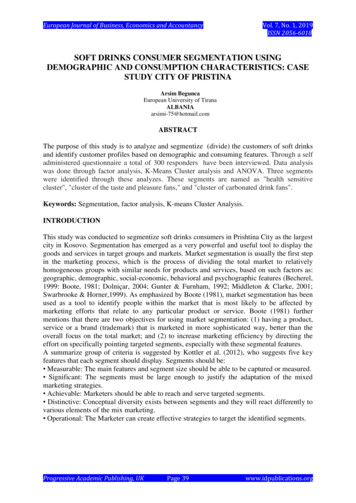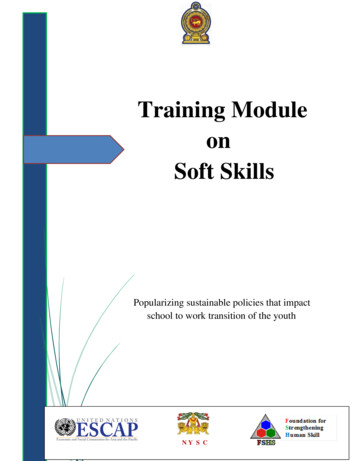
Transcription
Training ModuleonSoft SkillsPopularizing sustainable policies that impactschool to work transition of the youthNY S C
Online Training Module – Sri LankaFOREWORDIn the subject of career guidance, soft skills are the life skills that creates a positive environmentwhich enables a person to obtain a desired job that suits ones qualifications when he seeks a careeropportunity.Soft skills are essential in the professional arena as well as the daily life of a person. These skillsshould be established and developed and can be established and developed.The human is a social creature. This is why people are used to living in groups or herds ever sincethe time of evolution. Therefore it is clear that soft skills have been important and will continue tobe important for all people at all times.Soft skills are also important to lead a happy and peaceful life without mental stress. It has to beaccepted that soft skills make life easier.This module has been created to identify the essential soft skills and to practically train them usingvarious activities. This would pave the way for professional success and subsequently a society ofcontent citizens.NY S CPage 2
Online Training Module – Sri LankaEDITORIALA lot of attention is being paid to soft skills and its importance in the present. It is clear that socialisolation of man as well as the technology that have created the environment for this, is the causeof the reduced level of soft skills and the disregard for the soft skills that ought to be learned.When studying the behavioral patterns of today’s young generation it becomes evident that thissituation has affected them in a harmful manner. Work/Employment always expects teamwork.Almost all achievements in the workplace are results of teamwork. However electronic and digitaltechnology has isolated the man in the society. Soft skills are the instruments that can be used tobridge the gap between the individual demanded by the workplace and the socially isolated person.This module has been compiled by taking in to consideration the vitality of these soft skills/lifeskills.This module should be read carefully and completely when preparing for the training program.Also this module is a mere handbook of guidelines. It is the responsibility of the trainer to gatheradditional information. The additional information should be integrated to this module in such away that it doesn't affect the core principles. May you have the strength to conduct a successfuland effective training period!Wish you all success!NY S CPage 3
Online Training Module – Sri LankaCONTENTSPart 01Page NumberInstructions for trainersObjectives and targets5Objectives of the training moduleLearning ObjectivesPart 02Definition of Soft Skills6Importance of Soft Skills6Understanding Oneself7Creative Innovative Thinking8-10Problem Management11-12Stress and emotion management13-14Leadership14Teaming up14 -25Communication25-31Session Plan32Page 4
Online Training Module – Sri LankaPART 01Instructions for TrainersIt is better to incorporate the general instructions given regarding the training period, to thismodule as well. It is the responsibility of the trainer to decide the training duration based on theskills, knowledge and standard of the trainees.We expect to achieve better results by conducting a qualitative training through enriching themodule with personal experiences and providing successful responses to the participants' feedbackAims and ObjectivesTo create a generation of young employees who possess the soft skills expected by the workplace.Objectives of the ModuleTo fulfill the demand of the corporate world by creating a labor force, who possess the softskills and the ability to achieve workplace targets through practical team engagement?Nature of the Training and Training DurationNatureTime durationOtherCapacity building trainingworkshopThree DaysResidentialReflections and ReviewingworkshopOne DaysNon ResidentialLEARNING OBJECTIVESThe participants shall be able to achieve the following objectives at the end of this module1.2.3.4.5.6.7.Will be able to explain, what are Soft Skills?The ways and means by which soft skills can be utilized in the day to day lifeThe ability to face the everyday challenges of life with confidenceThe ability to deal with unpleasant situations and people with easeThe ability to showcase ones skills in a creative mannerThe ability to identify and showcase ones leadership skills via good people managementThe ability to become an outstanding personality in the social and work environment byskillfully maneuvering individual emotionsPage 5
Online Training Module – Sri LankaPART 02Soft SkillsIntroduction and DefinitionSoft Skills are the set of skills that a person should possess in order to face life's daily challengessuccessfully and to positively adapt to it. This would build the self confidence in an individual tohandle life challenges in a more effective manner.In order to visualize a clearer picture on soft skills, let us now look at some more definitions,1. Soft skills are the behaviors and characteristics that people demonstrate unconsciouslyand routinely(Daytona Beach Community College)2. For success in the workplace, the contribution of soft skills are 85% and contribution oftechnical skills are 15%3. Soft skills are learned through practice and experience(DDI International)4. Soft skills will take you higher in your profession while giving you the technical skillsto provide an efficient serviceThis module will introduce several important soft skills that are vital to overcome challenges in lifeDiscuss the importance of soft skills with the participants. Arrange their ideas in an orderlymanner.Then, discuss and emphasize its importance under the following topics.The Importance of Soft Skills To build and maintain interpersonal relationships.To make meaningful/appropriate decisionsEfficient CommunicationTo influence the professional developmentFor effective, efficient and higher performanceSoft Skills Understanding oneselfInnovative thinkingProblem managementStress and emotional managementLeadershipTeam workCommunicationPage 6
Online Training Module – Sri Lanka1. Understanding OneselfOne of the major issues that a person faces when reaching his/her life goals is, not havingunderstood who he/she is. This lack of understanding is the cause behind the inability to solveproblems efficiently or to logically reach a conclusion after assessing the pros and cons of aproblem.Therefore this topic will create an opportunity to identify a person’s skills, aspirations, qualitiesand personality traits.ACTIVITY 1Provide each participant with a model copy of a Johari window that is prepared according to themodel paper number 1Now, in square number 1 note down the things that you and others know well about yourself.In square number 2 write down the things that you think others think of you but you do not know.You can fill in this box by making an open invitation to the others.Square number 3 should be filled by facts that you and only yourself knows about you. Theseshould be secret to others.Square number 4 is the dark box. You should fill in it with facts that neither you nor others knowabout you.Points to consider when doing this activity1. Identify your strengths by paying more attention to square number 2 where you find out thepositive impressions others may have of you. By finding out the negative impressionsothers may hold of you, you can find out your weaknesses. Strive to turn these weaknessesinto strengths.2. Pay attention to square number 3.The facts about yourself that you thought were secretsmight not be a secret to some other people. However this box maybe smaller whensuccessfully interacting with the society.Page 7
Online Training Module – Sri LankaMODEL NUMBER 1Others Know1I knowOthers Don’t Know2. My Name. My Hometown Ability to Sing My Appearance My qualities3. Example: Generous personality sociableRed Colour4.I Don’tKnowGreenBlack2. Innovative ThinkingIn order to successfully overcome life's challenges and obstacles, one should free himself of thetraditional ways of thinking and adopt a new and creative way of thinking. Employing such novelmethods would help a person to reach ones goals in a unique manner with minimum effort. Toenhance creativity while departing from traditional thinking, some activities can be done.Page 8
Online Training Module – Sri LankaACTIVITY NUMBER 29 dot problemObjective:To make them understand that, in order to solve a problem, out of the box thinking and widerthinking is needed.Number of Particpants:For this activity as many participants as possible can be includedTime:25 minutesItems needed:Whiteboard/blackboard, pens and paper according to the number of participants.How to present:In a board that is visible to all participants, mark 9 dots. Instruct them to cut the 9 dots using 4lines.The lines should be drawn at a stretch while not lifting the pen from the paper and lines should notoverlap each other. The participants should be instructed to attempt this puzzle on their separatesheets of paper and once they have finished the puzzle the sheet of paper should be kept face downon the table. This activity will require about 8 minutes.Discuss with the participants if they faced difficulty while trying to solve the puzzle. Let themunderstand that the difficulty was due to the reluctance to draw the lines out of the box/frame. Butthere was no rule that said that drawing out of the box was prohibited.Lesson:The participants should learn that it is easier to face challenges if creative ways of thinking aresought instead of staying inside the traditional thinking framework.Page 9
Online Training Module – Sri LankaACTIVITY 3Necklace with 7 beadsA bankrupt businessman is leaving the town to go to a village. He tries to find a place to spend thenight in a small town on the way there. He thinks of spending a couple of days in this town to seeif he could restart his business in this new town. Finally he finds a rest house run by a woman. Thewoman agrees to provide accommodation in exchange of money. The poor businessman says thathe doesn't have any money but he has piece of a golden necklace with 7 gold beads. He asks thewoman to let him stay in the rest house for 1 gold bead per day. The woman agrees to provideaccommodation for 1 gold bead a day but also imposes a condition on the man. That is he isallowed to break the 7 bead necklace only at 2 points and he should provide her with a bead daily.Accordingly the businessman breaks the 7 beads in only 2 points and pays the woman with 1 beadper day. Thus he spends 7 nights in the rest house.Question: How did the businessman break the necklace in 2 points and how did he pay the womandaily?The lesson for the participants:When faced with a challenge creative thinking helps to minimize the loss and maximize the profit.Solution:The necklace is broken at 2 points to have 2 pieces of 1 bead and 2 beads each. On the first day hepays with the 1 bead part. The second day he gives the woman the 2 bead part and asks for thebead part back. On the third day he gives her the single bead. On the 4th day he gives her the 4bead part and asks for the 01 bead part and 02 bead part. On the 5th day he pays with a single bead.On the sixth day he gives the 02 bead piece and asks back for the single bead. On the 7th day hepays the woman with the single bead.Page 10
Online Training Module – Sri Lanka3. PROBLEM MANANGEMENTFacing problems are part and parcel of our daily life. But there are instances where people haveattempted suicide due to their inability to handle problems successfully. Therefore it has becomevital to learn the skill of problem management as a soft skill.ACTIVITY 4The story of the banana vendor (Individual Exercise)One day a banana seller crossed a 50m river and arrived at an island to get bananas for hisbusiness.Next he came to the bank of the river with 2 bunches of bananas of 50 bananas each.The banana seller asked the boatman to transport the 2 bunches of bananas to the other side of theriver. The boatman says that the transport fee to take one bunch of banana for 01 meter is 01banana. The seller agrees to this condition.The seller does not violate the contract but also saves some bananas for himself.Question:1. How many bananas are left to the seller after crossing the river?2. How many bananas are left, if any?3. Explain the way by which the transport fee is paid to the boatman?In order to solve the above problem, guide the participants to follow the steps below.1. Identifying the problem correctly/2. Finding out the reasons for the problem3. Identifying all the possible alternatives to solve the problem4. Selecting the best solution out of many alternatives5. Executing the solution and evaluationThe five-fold way given above can be utilized to solve the day to day challenges and problems too.Inculcate positive instruments in the trainees to help them practice this method regularly.Page 11
Online Training Module – Sri LankaACTIVITY 5American Romance (Group Activity)Divide all the participants in to groups of six and instruct them to role play as a family. Eachfamily should have a Mother, Father, Grandmother, Daughter, Elder Son and Younger Son.Introduce the following problem to all of them.Problem: The elder son is having a love affair with an American girl.This activity is to get all the family members to discuss about the issue at hand and to arrive at asolution. The trainer should distribute cards which indicate the name of the character and theattitude each character has towards the problem. (The trainer should be prepared with the cardsbeforehand)This activity will enable to identify the steps of the 'problem solving mechanism'1.2.3.4.5.6.7.Identify the problemIdentify the reasons behind the problemIdentify the alternatives for the problemAssess the alternativesSelect the best alternativeImplement the selected alternativeAssessment and ControlThe seven-fold way given above can be utilized to solve the day to day challenges and problemstoo. Inculcate positive instruments in the trainees to help them practice this method regularly.This part will provide a basic knowledge about the topic. For additional information werecommend referring the module number 4Page 12
Online Training Module – Sri Lanka04. STRESS AND EMOTIONAL MANAGEMENTTwo of the major causes behind stress are a person’s work environment and the complex socialbackground. Also there is a direct link between time management and stress management. Overwork, i.e. the work that cannot be completed within the work hours and work that exceeds yourcapability directly affects your stress levels.We go to our jobs while carrying the burden of many private matters which could decrease theefficiency and affectivity of the job. Also we come back home from work while carrying theproblems of work and the problematic situations we have created as a result of not workingefficiently. This may act as a vicious circle and reduce ones patience and endurance resulting in arestless mind and behavior.Stress can grow to a state where there is increased conflict, seemingly less solutions for problems,lack of creativity, isolation due to weakened interpersonal relationships as well as various mentalhealth issues.However there’s also a positive outlook on stress called “required stress”. An example is the stressinduced by fear of an exam which could motivate a person to study.Management of emotions such as anger, sorrow, and happiness has a direct relationship with themanagement of stress. Relaxed and free mind will distance you from anger. Managing onesemotions to prevent harmfully affecting oneself or others is a quality of a great personality.Management of emotions is not the same as not expressing the emotions. There should be freedomto cry when sad, to smile or laugh when on is happy. The point here is that emotions should notnegatively affect one or any others. It is also necessary to do away with the social misconceptionthat men should not cry. Explain this to the participants.When you manage your emotions, you will be at ease. Solve a problem in its early stages rather than letting the problem worsen To only have realistic hopes. That is living with achievable, feasible targets rather thanimpossible dreams. Engage in activities that you enjoy outside of work. Start a new hobby and maintain it. Practice a relaxing exercise daily even for a short while. Exercise regularly Share your problems or worries with your spouse or trustworthy friends. Discuss your lifeplans Create a good plan. Manage your time accordingly. Take a small break from every two hours of work Get enough sleep Check if the food that you consume is healthy enough. If it’s not, get used to a healthyeating pattern. Get a full medical checkup annually Drink the required amount of water daily. (Medically advised amount) Make it a habit to drink water Walk in way that the entire sole of the foot touches the floor. Get rid of the thoughts that make you think that things should only happen in a particularway and in that way only.Page 13
Online Training Module – Sri LankaTrainers InterferenceGuide the participants to think of the difficulty and the effort needed to solve a problem whenattempting the first individual activity and the second group activity. Has the participantsadequately developed their skill? Let the participants understand that the proposed mechanism canbe used to easily deal with the everyday problems.5. LEADERSHIPLet us understand the concepts about leadership. A leader can be identified as a person whomotivates and guides the people who are striving to achieve a common goal in the family, societyor workplace.The unfortunate situation of today is that most people are waiting for a person to guide thembecause they have failed to identify the leadership qualities within him/ her. Even if one gets theleadership opportunity it is more challenging to maintain it. Therefore leadership is a soft skill thatneeds to be developed.ACTIVITY 6Understanding LeadershipWhat qualities do you see in the following leaders? Nelson Mandela Mahatama Gandhi Adolf Hitler Marting Luther king West India leader Siyatel6. TEAMING UP It’s important to understand what a team isEngage in a discussion with the trainees about the feature of a teamList down the discussed features based on their preferenceCompare the following definitions with the features brought forward by the trainees Common Goal The importance of each team members contribution to achieve acommon goal Interaction between team membersPage 14
Online Training Module – Sri LankaLet us consider a few more definitions about teamsIt is a group of two or more people who engage in interactions regarding each other’s membershipand members who are aware of the positive interdependence when trying to reach mutual goals(Johnson and Johnson 1987,8)A team is a group of people from a certain social class, with a permanent interrelationship of dutyamong each otherA team is a collection of people with a definite and a common convention regarding attitudes,emotions, aspirations and goals based on important factors that affect each member who has anexpress or implied assessment.(Hog and Abrahams 2001)The Development Stages of a TeamStage One: FormingThe stage where team members get together and gets to know each otherStage Two: StormingThis stage discusses and argues about individual roles while creating a competition for the role ofleader.Stage Three: NormingThe team members discuss, decide and establish the habits and activity.Stage Four: PerformingThis is the stage where the team perform their dutis and shows stabilityStage Five: AdjourningThis stage sees the conflict between the members who wishes to drift apart and the members whotry to maintain the team(Kurt Lewin 1930 USA)Page 15
Online Training Module – Sri LankaFeatures of an Efficient Group Fulfills the targets and dutiesMaintaining the goal of achieving common targets (internally)(Balancing the duties, interrelationships and team maintenance)Developmental change so as to increase the efficiencyExplain to the trainees about the stages of a team, the features of an effective team,how theachievement of workplace targets is a collective effort and the fact that each team member is adifferent person with varied habits and that it is an art to work with each person cooperatively.It is clear that it’s possible to attain the common objectives of a firm/company as well as one’sindividual goals by becoming an efficient team member in an efficient team.The trainees should understand that our individual goals cannot be attained in isolation and that weneed the help of others to reach our goals.An efficient team, Has collectively identified and understood the final target and objectives. These objectivesmust be bound and interdependent on the objectives of the team members while being ableto achieve a high level of commitment.There should be effective communication between the team members.The leader or the members should not have any hidden agenda or motives.All members should handle responsibility. The duties and responsibilities should beperformed in due time in the due manner. Participation and Leadership should be equallydistributed among members. The members should be content about their membership.Should have common agreements which are protected by all members. Should makeappropriate measures and decisions when need arises.Power and influence should be equalOpposing views and ideas should be encouraged. That nurtures qualitative decision makingMembers should have cooperation, mutual trust, unity, acceptance, pleasantness andrespect for each other.High competence of problem solvingA mechanism should be established to assess and evaluate the efficiency and performanceof the team as well as individual contributions and commitmentPage 16
Online Training Module – Sri LankaTEAM BUILDINGACTIVITY 07Broken Squares (From low to middle level risk)Based on an edition of the Law Enforcement Career res.docThis activity requires a certain preparation beforehandDivide the participants into smaller groups. You must prepare a set of broken squares as givenbelow for each team. Cut 5 cardboard squares of 15 x 15 cm. Mark them slightly using a pencil.(Write lightly so that it can be erased off later)The lines should be drawn in such a way that all the pieces marked as “a” should be of a certainsize and all the pieces marked as “o” should be of another size.After drawing the lines and marking the letters on them cut them out so as to make them pieces ofa puzzleTake 5 envelopes/ paper bags and number them from 1 to 5. Next put the pieces of cardboard in tothe envelope according to the following instructions. Pieces I,H,E in envelope number 1Pieces A,A,A in envelope number 2Pieces A,J in envelope number 3Pieces D,F in envelope number 4Pieces G,B,F,C in envelope number 5ABDFCCEAFIGJKAAPage 17
Online Training Module – Sri LankaErase the letter written in pencil on each piece of board and write the letters on the relevant covers.Thereafter, on the completion of the group task the pieces of board could be easily put into therelevant cover.Group five students per team and appoint an observer/judge for each team. If there are additionalparticipants remaining more than one observer/judge can be appointed. Distribute 5 covers each with pieces of broken squares to each groupDistribute the broken squares group sheet instruction sheet to each group (provided below)Distribute broken squares judge instruction sheet to each judge(provided below)Inform that each team will get 20 minutes to complete the given task and to create fiveperfect squares of equal size.Supervise the task to ensure that teams follow rules.Discuss experiences at the end of the group task. Allow the observers to share observations withthe team. Relate these experiences to real life scenarios. Questions to direct the team are below. What are the emotions experienced during the activity?Have you experienced similar emotions when working with other teams?What is the relationship of this activity to your work or societal situations?Discuss what is meant by cooperation and build hypotheses on successful collaboration in solvingproblems. The important aspects to be considered are, Every individual should comprehend the entire problem.Every individual should understand how to contribute in solving the problem.Every individual related to the problem should be aware of the contributory strengths ofother members.Page 18
Online Training Module – Sri LankaBROKEN SQUARES GROUP INSTRUCTION SHEETEach of you has an envelope which contains pieces of cardboard for forming squares. When thefacilitator gives the signal to begin, the task of your group is to form five squares of equal size. Thetask will not be completed until each individual has before him a prefect square of the same size asthose in front of the other group members.Specific limitations are imposed upon your group during this exercise: No member may speakNo member may ask another member for a piece or in any way signal that another person isto give him a piece (members may voluntarily give pieces to other members)BROKEN SQUARES OBSERVER/JUDGE INSTRUCTION SHEETYour job is part observer and part judge. As a judge, you should make sure each participantobserves the following rules: There is to be no talking, pointing or any other kind of communicatingParticipants may give pieces directly to other participants but may not take pieces fromother membersParticipants may not place their pieces into the center for other to takeIt is permissible for member to give away all the pieces to his puzzle, even if he hasalready formed a squareAs an observer, look for the following. Who is willing to give away pieces of the puzzle?Does anyone finish “his” puzzle and then withdraw from the group problem solving?Is there anyone who continually struggles with his pieces, yet is unwilling to give any or allof them away?How many people are actively engaged in putting the pieces together?What is the level of frustration and anxiety?Is there any turning point at which the group begins to cooperate?Does anyone try to violate the rules by taking or pointing as a means of helping fellowmembers solve the problem?Page 19
Online Training Module – Sri LankaCONFLICT RESOLUTION/MANAGEMENTWhat is meant by a conflict?Make an effort to define it. List out factors that should be included in the definition. Consequentlycompare your effort with the definition below.Conflict is a process that begins when one party perceives that another party has negativelyaffected, or is about to negatively affect, something that the first party cares about.(Robbins M L, 1994)Conflict can be simply categorized into two.1. Task ConflictConflict that originates on content or goals of work and over how work gets done.2. Relationship ConflictConflict that is based on hostile interpersonal relationships with a person or groupDifferent spheres of conflict1. Interpersonal Conflict2. Intrapersonal Conflict3. Intragroup Conflict4. Intergroup ConflictSituation 1Situation 2Source ofConflictIdentifyingthe ConflictAntecedentconditionsPerceivedconflict Communication Structure PersonalvariablesFelt conflictSituation3Procedure totackle theconflictConflict-handling5.intentions6. gAccommodatingSituation 4Behaviour in aConflictOvertConflict Party’sbehaviour Other’sreactionSituation 5Outcomes ofa ConflictIncreased groupperformanceDecreasedgroupperformancePage 20
Online Training Module – Sri LankaCONFLICT MANAGEMENT STYLESHow do people act with regard to conflicts? What are the best techniques used for conflictresolution? What are the most successful techniques? All these styles and techniques should havethe ability to connect views, feelings, emotions and their diverse behavioral patterns. The decisionstaken by people to resolve conflict using certain techniques may be a result of the training theyreceived on conflict resolution. In a way although these efforts could be wise and clever, thesetechniques may not be suitable in certain situations.It is important to know that there is more than just one way to solve conflicts. It is dependent uponthe relevant conditions of the particular situation. It varies with the scenario. The most suitableoption is to use a specific style of conflict resolution.One must understand that it is important to carefully select the most suitable technique or style insolving a conflict successfully. Before reacting or responding to other characters involved in theconflict and their behavioral patterns, one must first try to presume their expectations and thenselect the best conflict resolution technique based on their suggestions. The various aspects andsegments of the conflict should be well analyzed as a possibility exists where one party may seekto aggravate the issue while the conduct of the other party may infer incorrect intentions. It shouldbe noted that actions and behavior of a person who is extremely annoyed and short tempered,should not be a factor to correctly determine his expectations.No conflictsSlightdisagreementsor lack ofunderstandingConflict eradicatedQuestioningopenly orchallengingThreatening orannouncingthe finalwarningPhysicalattacking tocreate aconflictObvious effortsto destroy theother partyThe book titled “Continuous Intensification of Conflicts” authored by Stephen P Robbins (1974)presents ways and means to detect the development of conflicts.Page 21
Online Training Module – Sri LankaRESULTS OF BEING FUNCTIONALWhen people tend to be novel, creative, strategic and energetic as a result of their decisionsproving to be p
1. Soft skills are the behaviors and characteristics that people demonstrate unconsciously and routinely (Daytona Beach Community College) 2. For success in the workplace, the contribution of soft skills are 85% and contribution of technical skills are 15% 3. Soft skills are learn

